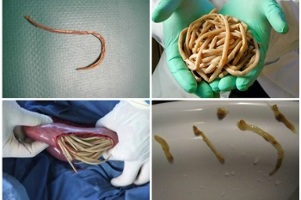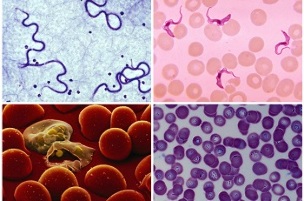There is a risk of getting worms without leaving home. A variety of helminths can be found on appliances, foil, dishes, food, in drinking water.
The parasites enter the human body in a way convenient for them: they can enter the digestive system with food, water, through dirty hands or insect bites.
Furthermore, helminths affect some internal organs, use the resources of the human body, cause mechanical damage and actively reproduce. Their vital processes are accompanied by bothersome and often dangerous symptoms and damage to various organs.
How to recognize intestinal worms

Worm disease combines a group of diseases caused by different types of worms. Usually, it is possible to detect roundworm (roundworm), filariasis (pinworm), hookworm (hookworm). These parasites live in the lumen of a human, eating their contents and their presence can be suspected by a number of characteristic symptoms:
- Spectacular weight loss without changes in diet and physical activity. The intestinal helminthiasis uses nutrients of the human body as a source of energy to grow and reproduce, while fixed devices in the intestine (suck, hook) damage the intestinal wall and interfere with absorption. remaining trace elements.
- Abdominal pain, umbilical cord, anal rectal itching is caused by worms moving, mechanical damage they cause, as well as the discharge of larvae or adults from the body to the outside environment.
- Various digestive disorders: diarrhea or constipation, flatulence, mucus, foam or blood in the stool, nausea, vomiting. In some cases, the adult parasite can be found in the feces.
- The human body can react to the appearance of a parasite with an allergic reaction, an intoxication caused by the waste of helminths. This is usually manifested by itchy skin, redness of certain areas, a rash (blisters, blisters of different sizes).
Diagnosis of intestinal helminthiasis includes stool study, clinical and biochemical blood tests (eosinophilia, leukocytosis), and, if necessary, ultrasound data of the body.
Signs of parasites in the liver
A large amount of nutrients accumulate in the human liver, and blood circulation is strong, conducive to the parasite. Common liver helminthiasis: small liver fluke disease, small liver fluke disease, helminthiasis caused only by worms of the liver fluke group.
You can define them with specific characteristics:

- The throbbing pain in the right hypochondrium is due to the mechanical action of the helminths. Thus, echinococcus form cysts in the tissues of organs, provoking the development of inflammatory or even necrotic processes.
- Adult worms (roundworm) can block the bile ducts, so the output of the bile is disturbed, the digestive process in the body is difficult, the patient has signs of jaundice. A person's visible mucous membranes are yellow and with the development of pathology the skin becomes stained.
- The nonspecific symptoms of the onset of parasites will be general deterioration of the body, weight loss, nausea, coma.
To clarify the diagnosis, they donated blood for analysis. Detect leukocytosis, eosinophilia, biochemical tests will show an increase in activity of liver enzymes (ALT, AST). During an ultrasound, the liver damage will be clearly visible: enlargement, inflammation and in some cases, parasitic cysts can be found.
What indicates the presence of helminths in the lungs
Some parasites (roundworm, toxoplasma, echinococcus, tsenur) can enter from the digestive tract into the lungs of people with blood or lymphatic blood. They multiply in the alveoli, causing breathing difficulties, and some species (echinococcus unicameral) form cysts, damaging the structure of the organ.
It can be difficult to determine the presence of parasites in the lungs, since the symptoms are similar to the manifestations of respiratory diseases caused by viruses and not caused by infections (bronchitis, ARVI). Cough, shortness of breath, chest pain, and fever indicate the need to examine the patient's body.
To diagnose helminthiasis, the X-ray method will bring out the most information. Photos will show human lesions caused by echinococcus (cysts) and bovine tapeworms (filaments), which should then be distinguished from tumors, cysts of various etiologies and pneumonia.
Parasites in the blood

Protozoa single cell worms can be found in the lumen. Babesias, plasmodia (plasmodium malaria), trypanosomes, microfilariae, schistosomes cause life-threatening illnesses.
Destroying shaping factors, they disrupt energy metabolism in the body and block the supply of nutrients to organs and tissues.
In most cases, human infection occurs after being bitten by an insect or tick. After a while, the body shows signs of anemia: pallor, cyanosis, dizziness, sudden weight loss and declining health. Without timely medical care, parasites in the blood can seriously threaten human life.
The diagnosis includes conducting microscopic blood tests, in which one-cell parasite and destroyed red blood cells can be found, as well as the type of worms. The treatment is long-term, carried out locally under the supervision of a qualified physician.
Abnormal habitat of the parasite
Certain types of helminths can enter the human heart, subcutaneous tissue (dirofilariae), brain and spinal cord (cysticercus, echinococcus). Can become infected not only in unfamiliar countries, but also by eating familiar food that has not been properly heat treated, and pets can become carriers of disease. Signs of invasion depend on how much damage a particular organ has.
In the brain, worms can form follicles, the filaments that cause neurological phenomena.

Unexplained headache, tremor (tremor) of extremities, altered tactile sensitivity, impaired coordination of movements, sharp impairment of hearing and vision - signsof invasive development depends on the location of the worms and their larvae.
Adult parasites can be seen under the skin, often accompanied by itching and a prickly sensation, as well as in the eyes, ear canal and elsewhere.
What to do if you see signs of worm infection
Parasitic diseases are treated under medical supervision after all necessary examinations and identification of the parasite. Prescribe a wide-acting or narrow-spectrum anthelmintic, perform restorative and symptomatic therapy, promote removal of the worms from the body. In some cases, surgery is indicated.
The prognosis of most diseases is favorable if treatment is started at the right time. If you delay seeing a doctor or start taking medication on your own, the healing process can be delayed and many types of parasites can damage vital organs or body systems, or even lead todead.





























